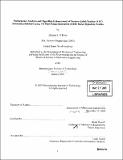Performance analysis and algorithm enhancement of feature-aided-tracker (FAT) simulation software using 1-D high-range-resolution (HRR) radar signature profiles
Author(s)
O'Brien, Michael J. (Michael James), 1981-
DownloadFull printable version (22.37Mb)
Other Contributors
Massachusetts Institute of Technology. Dept. of Mechanical Engineering.
Advisor
Derek Rowell.
Terms of use
Metadata
Show full item recordAbstract
The current Lincoln Laboratory (LL) MATLAB Feature-Aided-Tracker (FAT) software was adjusted and appended to provide a robust ground-target radar tracking simulation tool. It utilizes algorithms from the LL UAV Radar Moving Target Tracker (1991) and the LL FAT Tracking Software (2002). One-dimensional High-Range-Resolution (HRR) radar signature target profiles were used to assist in track-to-report data association through classification-aided and signature-aided tracking (CAT and SAT) algorithms. Profiles were obtained from the DARPA-sponsored Moving Target Feature Phenomenology (MTFP) program. Performance Analysis of this simulation tool reinforced the hypothesis that target aspect angle error estimation (state estimation) drives the performance of CAT, SAT, and Kinematic Tracking (KT) algorithms. A decaying exponential relationship exists between the Kalman filter estimate of target-speed and expected aspect angle error. This relationship was exploited to optimize the allocation of computational resources while enlarging the database aspect angle search in CAT to improve performance. Vehicle classification accuracy is improved by 70% and data association accuracy is improved by 12% in kinematically ambiguous situations such as when target intersections occur. SAT was improved 3% using this knowledge. Additionally, the target report HRR profile from each scan was used to generate an "On-The- Fly" SAT HRR profile database. This algorithm tests the similarity between the current target report HRR profile and the database HRR profiles. If there is sufficient resemblance, the report HRR is added to the database; if not, the database is reset. (cont.) This information can be employed to provide up to a 9% performance improvement over the previous version of SAT in a best-case scenario. In realistic situations, a 6% performance improvement is still attainable. If a large, accurate database exists, near-perfect data association is achieved. Overall, the above technique adjustments provide an improvement of 6.3% (13.6% in realistic, GPS-generated scenarios) in data association accuracy over the initial FAT algorithm and a corresponding 28.8% improvement over the results of the KT itself.
Description
Thesis (S.M.)--Massachusetts Institute of Technology, Dept. of Mechanical Engineering, 2005. Includes bibliographical references (p. 94).
Date issued
2005Department
Massachusetts Institute of Technology. Department of Mechanical EngineeringPublisher
Massachusetts Institute of Technology
Keywords
Mechanical Engineering.